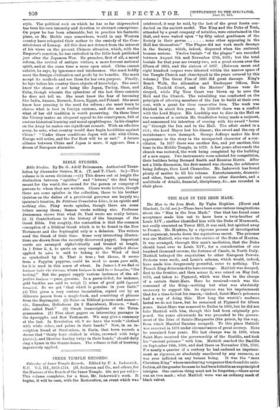INNER TEMPLE RECORDS.
Calendar of Inner Temple Records. Edited by F. A. Inder wick, K.C. Vol. III., 1660-1714. (H. Sothers.n and Co., and others, for the Masters of the Bench of the Inner Temple. 20s. net per voL)— This volume completes, for a time, Mr. Inderwick's work. It begins, it will be seen, with the Restoration, an event which was
celebrated, it may be said, by the last of the great feasts con- ducted on the ancient model. The King and the Duke of York, attended by a great company of notables, were entertained in the Hall, and were waited upon " by fifty select gentlemen of the Society in their gowns none other appearing in the Hall but themselves." The Plague did not work much damage in the Society, which, indeed, dispersed when the outbreak became serious. Twelve burials "of the plague" are recorded between August 9th and November 17th, 1665; but the total burials for that year are twenty-two, not a great excess over the fifteen of 1664, and the sixteen of 1667. (Between seven and eight hundred corpses were interred within the narrow space of the Temple Church and churchyard in the years covered by this volume.) The Great Fire of 1666 did great damage. King's Bench Walk, the Alienation and Exchequer Offices, Ram Alley, Tanfield Court, and the Masters' House were de- stroyed, while Fig Tree Court was blown up to save the Hall and the Church. The rebuilding was conducted on the principle of allowing members of the Inn to build at their own cost, with a grant for three consecutive lives. The work was finished in about five years. In 1668-69 there was a conflict with the Lord Mayor. His Lordship was to dine in the Hall on the occasion of a certain Mr. Goodfellow being made a serjeant, and announced his intention of coming with his sword "borne up" through the Inn and in the Hall. The affair ended in a riot; the Lord Mayor lost his dinner; the sword and the cap of maintenance were damaged. George Jeffreys makes his first appearance in the story in the unexpected character of a con- ciliator. In 1677 there was another fire, and yet another, this time in the Middle Temple, in 1679. A few years afterwards the church was restored, the work being completed by the building of a new organ. Two instruments were selected for competition, their builders being Bernard Smith and Renatus Harris. After not a little discussion, the first-named was chosen, the arbitrator being Jeffreys, then Lord Chancellor. Mr. Inderwick has found plenty of matter to fill his volume. Entertainments, dramatic and other, feasts, quarrels and various other disorders, and a multitude of details, financial, disciplinary, &c., are recorded in their place.




















































 Previous page
Previous page